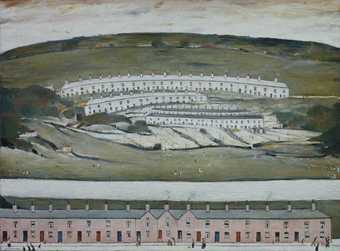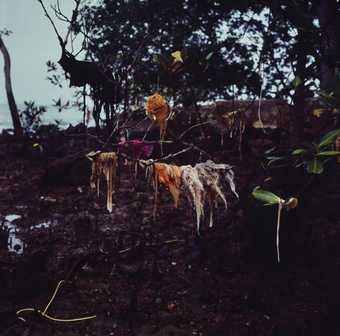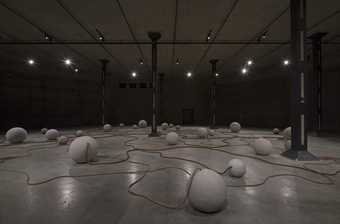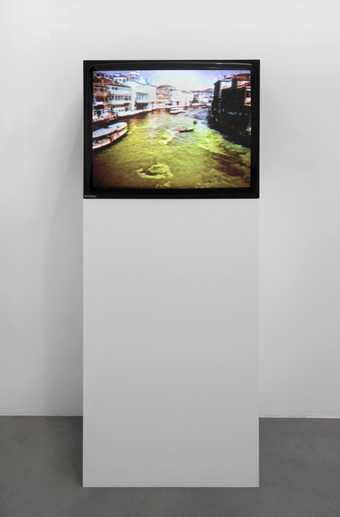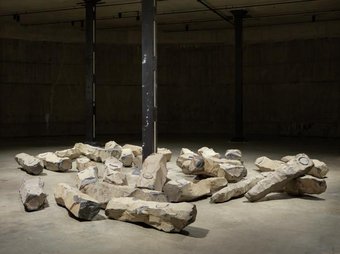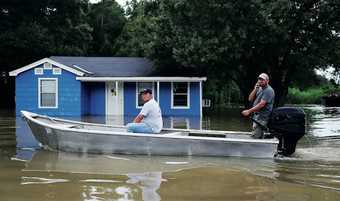No. Well, not on its own.
But art can help us understand the impact our societies have had on the world we live in and inspire us to take action.
The term climate emergency wouldn't have meant much to artist L.S. Lowry but his paintings of the north of England show the effects of mass industrialisation on the natural and urban landscape.
Billowing clouds of smoke from huge factories dominate the scene. The people seem anonymous and powerless in comparison.
In Simryn Gill’s photographic series Channel humans aren't visible at all. We only see what they've left behind. Gill's photos document the pollution of the mangrove forests in her hometown of Port Dickson in Malaysia. The rubbish almost seems part of the natural world: brightly coloured flowers or fruit hanging from the trees.
There's a cargo ship on the horizon. Perhaps Gill is pointing to globalised trade and the uneven impact it has on nature and local communities.
In this work artist Abbas Akhavan covers
the gallery floor
with bronze sculptures of plants
native to Iraq
Study for a Monument was made
with the assistance of images
provided to me by
Dr. Sophie Neil
from the Royal Botanical Gardens of Edinburgh
Working from these images
I sculpted these plants out of wax
much larger than their actual size
to make them this scale
of what you would find
at the base of a monument
Laid out on white bedsheets
the sculptures
resemble specimens
undergoing scientific study
confiscated goods
objects in a street market
or bodies prepared for mass burial
When I was watching on television
and in newspapers
images of the Iraq invasion
iconoclastic images of American soldiers
tearing down these massive
egomaniacal monuments
that Saddam Hussein
had built for himself
I was thinking of
How do you reconsider the kind of human
centric memorials and monuments
that are often pyramid shaped?
This kind of pyramid vertical shape
is something
that I responded to with this work
which is horizontal
fragmented
has a bit of a more precarious
or transient mode of display
After the first Gulf War in 1991
Saddam Hussein destroyed
the Mesopotamian marshlands
to eradicate the Shia
rebels who lived there
The technology to drain the
marshes had been developed
by the occupying
British Mandate
earlier in the 20th century
This work is aimed at reconsidering
what we memorialise
One of the things that we don't consider
in a popular collective consciousness
is the ecological damage of war
What happens to the soil and the toxicity
on the ecology
of the landscape
in the aftermath of these wars?
Otobong Nkanga is interested
in the bling
of everyday cosmetics and technology
and our disconnection
from the social
and environmental
cost of their production
I think one thing
I would like to talk about
was the notion of
dependency and of addiction
When you see that kinds of scars
we have in our landscape
we are drug addicts in a way
and the drug is the resources
If we start thinking in such a way
that we're that connected
and that we are also
part of elements that are in the soil
we will maybe
think of the way we work
within our landscape differently
Some artists work with
the landscape directly
taking action
outside of museums and galleries
During the Venice Biennale in 1968
Nicolás García Uriburu
poured a chemical called Fluorescein
into the waters of the Grand Canal
This nontoxic chemical
reacted with micro-organisms in the water
and turned the canal bright green
He was making a point
about water pollution
and how we need to treat this precious
and increasingly scarce resource
with more care and respect
He went on to repeat this action
in rivers and coastlines around the world
In different ways
Artists bring us face to face
with the realities
of natural destruction
whether through climate
war
or pollution
They also urge us to think about new ways
of imagining a more sustainable world
and prompt us to take collective
action to make it a reality
This video explores ideas of death and contains images of burial that may be difficult for some viewers.
In this film, we take a look at artworks by L.S. Lowry, Simryn Gill, Abbas Akhavan, Otobong Nkanga and Nicolás García Uriburu, to explore how these artists raise issues connected to the environment and inspire us to take action.
Research supported by Hyundai Tate Research Centre: Transnational in partnership with Hyundai Motor.

